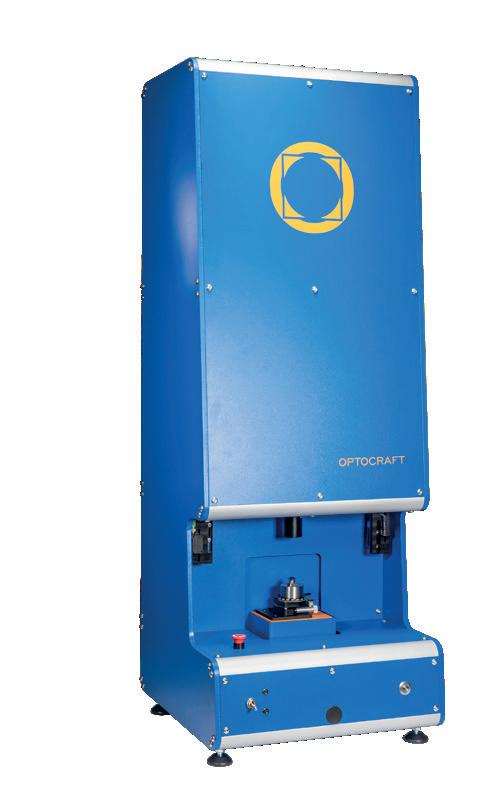
5 minute read
Top(t)ics
An aberration
Contact lens optics is one of the most interesting but increasingly one of the most controversial areas of optometric education. In many European countries, the profession of optometry stemmed from optical schools and optics education, which gradually (or not so gradually sometimes) transitioned into health care-related tasks and responsibilities. The professional body in Europe is called ‘European Academy of Optometry and Optics’, which held its annual meeting recently in Dublin from May 12-15. In the United States, it is a bit different: optometry as a profession originated more than a century ago, and the national association is simply called ‘the American Academy of Optometry’. By Eef van der Worp Photo: Frank Sonnenberg
Advertisement
OF HIGHER IMPORTANCE
Optics used to be an integral part of the education system for the profession. But in the US certainly, and more now in Europe, we see that education on optics is increasingly reduced. There is logic behind this: it completely makes sense that for an optometric professional to take on all of the responsibilities to ensure healthy eye care, a more-than-substantial portion of the education should be devoted to anatomy of the eye, ocular physiology, eye disease and pharmacology. With most education programs being only four years maximum in length, something needs to give. And indeed, curriculum changes typically are made at the expense of optics and the more technical parts of the education program.
This prompted Pete Kollbaum, a US optometrist who is surely an exception to the rule, to write a column in softspecialedition.com newsletter titled: Higher Order Aberrations – of Higher Importance. He urges the profession and the industry to not forget about contact lens optics in higher education and to invest in education in this field. He mentions the huge challenges, but also the great possibilities, when we incorporate and apply better optics to the different lens modalities. The sky is almost unlimited, but only if we understand the optics side of things, including that of higher-order aberrations.
CORNEAL & SCLERAL LENS OPTICS
Corneal rigid lenses have always provided excellent vision. It is almost ironic to see that the good old rigid lens corrects and provides vision that would qualify as ‘higher-order-aberration’corrected lenses. About 90% of all corneal aberrations are corrected automatically (the rest is lost because of the difference in index of refraction between the lens material, the tear film and the cornea). In fact, if you perform aberrometry with and without a rigid lens on the eye and subtract these two maps (like in an orthokeratology topography map), you will get the higher-order aberration profile map of the tear film behind the lens. Pretty cool.
Scleral lenses do the same, as they are rigid too, but an excellent paper by Vincent and Fadel pointed out that the ‘thin lens’ optics of rigid lenses on the eye simply cannot be applied when it comes to scleral lenses. Indeed, there is still a discrepancy, as many in the industry may tell you that the optical performance of scleral lenses – especially if there is more vault – will not be
the same as that of corneal rigid lenses. Some patients simply continue to prefer the latter. It’s all in the contact lens optics.
CUSTOMIZING SOFT
Of all the specialty lenses, soft customized lenses may have the biggest potential in our field. First, we must better understand standard soft lens fitting. Work by Graeme Young et al confirmed that soft lenses need to be fitted ‘somewhat steeper’ than the ocular surface to gain the desired ‘grip’ on the eye. In our terminology, we call this the delta-sag: the difference between the sagittal height of the ocular surface over a given area and the contact lens sagittal height so that the lens can bend or deflect to do so. This shows that any given soft lens on the eye needs to bend or flex to successfully fit the eye. By how much exactly is still up for debate. And in current lens wearers, this value varies by quite a bit. This also means that the deflection in some lenses may be 100 microns, while in others it could be several hundred microns. What does that do to the optics of a lens? We don’t know. In a standard -3.00D spherical lens design, it probably will not generate more than a 0.25D change. But in more complex lens designs – e.g., toric, multifocal and myopiacontrol – this could prove to be more than trivial. Understanding this, and then applying that to soft lenses – taking the individual and general characteristics regarding age and pupil size into account – could potentially have a huge impact on myopia management outcomes in kids and also could improve multifocal soft lens fitting for presbyopia.
DEDICATION IN EDUCATION
This all means that we need to dedicate adequate time and energy to optics education. I am personally happy that I was first trained as an optician, followed by an education as optometrist. But we cannot expect that from most of the graduates coming out of optometry school today. If optics education is overshadowed by other important topics, it may be a task of the industry to step in and to keep educating young professionals to remain up-to-speed with all of the cool things that contact lens optics can bring to them, to the profession, and to their patients. n
Hughes et al. Higher order aberrations, refractive error development and myopia control: a review. Clin Exp Optom. January 2020 Kollbaum. Higher Order Aberrations – of Higher Importance. softspecialedition. com. Spring 2022 Van der Worp . Variation in sag values in daily disposable, reusable and toric soft contact lenses in the journal. Contact Lens and Anterior Eye. December 2021 Vincent SJ, Fadel D. Optical considerations for scleral contact lenses: A review. Cont Lens Anterior Eye. 2019 Dec;42(6):598-613 Young G, Hall L, Sulley A, Osborn-Lorenz K, Wolffsohn J. Inter-relationship of soft contact lens diameter, base curve radius, and fit. Optom Vis Sci 2017;94:458–65
Eef van der Worp, BOptom, PhD, FAAO, FIACLE, FBCLA, FSLS is an educator and researcher. He received his optometry degree from the Hogeschool van Utrecht in the Netherlands (NL) and has served as a head of the contact lens department at the school for over eight years. He received his PhD from the University of Maastricht (NL) in 2008. He is a fellow of the AAO, IACLE, BCLA and the SLS. He is currently adjunct Professor at the University of Montreal University College of Optometry (CA) and adjunct assistant Professor at Pacific University College of Optometry (Oregon, USA). He lectures extensively worldwide and is a guest lecturer at a number of Universities in the US and Europe.
Advertisement
Keep an eye on lens shape and process quality!
SHSOphthalmic autoROC
Semi-finished lenses, tools, molds Spheric, toric, aspheric surfaces

RoC, Q, surface shape, tool offset NEW: self guided sample measurement Accuracy: RoC: 2µm | Surface shape: 0.1µm

Know your quality! Metrology for contact lenses & intra ocular lenses.










